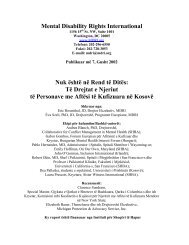Torture not Treatment - Disability Rights International
Torture not Treatment - Disability Rights International
Torture not Treatment - Disability Rights International
You also want an ePaper? Increase the reach of your titles
YUMPU automatically turns print PDFs into web optimized ePapers that Google loves.
TORTURE NOT TREATMENT<br />
added to the use of the GED when the aversive power of electricity alone is <strong>not</strong> sufficient. As<br />
described on the JRC website, ―[T]he safest way to do this is to use mechanical restraint to<br />
contain the student, in a prone position, on a flexible plastic restraint platform that has been<br />
specially designed for the purpose.‖ 31 It is worth <strong>not</strong>ing that, outside JRC, the use of any<br />
―prone‖ (face down) restraints are widely considered to be inherently dangerous, and many states<br />
have banned any form of prone restraints in the mental health context. 32<br />
JRC‘s rationale for the use of powerful shocks and other aversives – both in the past and<br />
currently – is that his facility serves some children or adults with the most severe cases of selfinjurious<br />
behaviors, <strong>not</strong> controlled with any other treatment. 33 According to JRC, parents come<br />
to JRC after all other services have failed.<br />
JRC is technically a school, licensed by the Massachusetts Department of Elementary &<br />
Secondary Education, and children are theoretically placed there voluntarily. It additionally<br />
receives its Level III aversive certification by the Massachusetts Department of Developmental<br />
Services (formerly Department of Mental Retardation) as well as licensing for its over residential<br />
program for adults over 22 years old. Children and adolescences‘ residences at JRC are licensed<br />
by the Massachusetts Department of Early Education and Care.<br />
The voluntary consent to treatment, however, is a legal fiction for children and adults with<br />
disabilities who have been declared mentally incompetent. In practice, parents or guardians<br />
consent to placement at JRC. 34 Once there, JRC must seek a court hearing to request permission<br />
to use electric shock or other Level III aversives on residents. Referred to as a ―substituted<br />
judgment‖ hearing, the court determines whether the child or adult would have chosen to receive<br />
such treatment if he or she were competent to do so. 35 Parents or other legal guardians must also<br />
approve the use of the GED. The court rarely denies approval.<br />
JRC is <strong>not</strong> an open facility but a closed institution where children are transported from their JRC<br />
owned and operated residences to the JRC school in shackles. As the NYSED report stated in<br />
2006:<br />
Students were observed as they arrived and departed from school. Almost all were<br />
restrained in some manner, with metal „police‟ handcuffs and leg restraints, as they<br />
boarded and exited vehicles. Several students are transported in wheeled chairs that<br />
keep them in four-point restraint.<br />
In practice, for many residents, JRC is a closed institution where children and adults with<br />
disabilities are segregated from the non-disabled world.<br />
9




